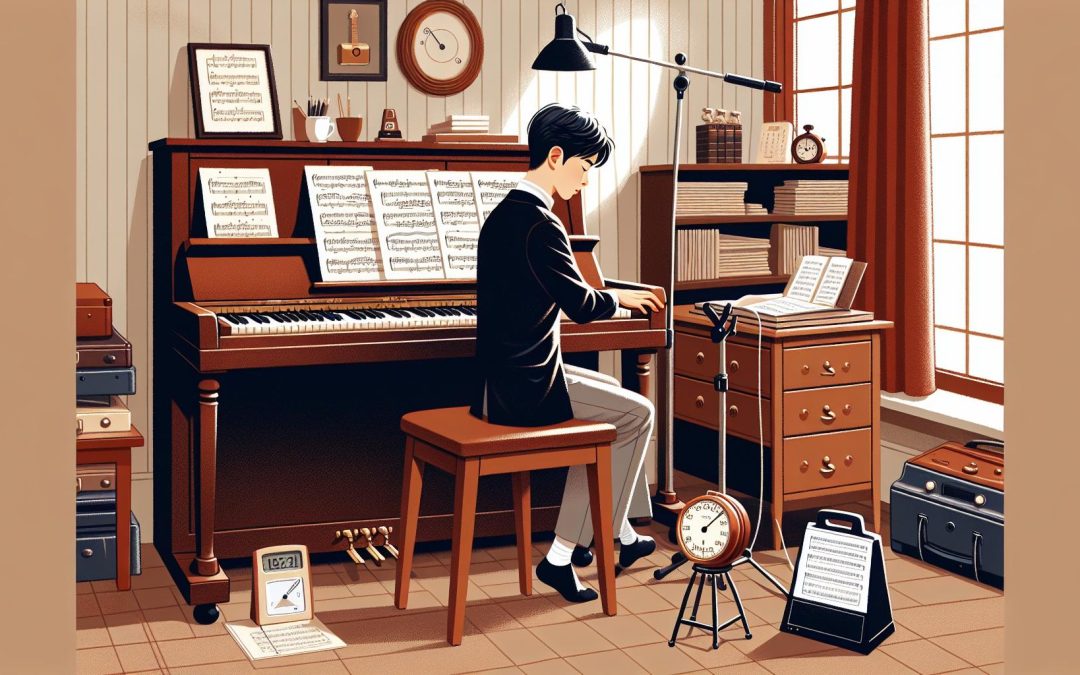Transposing keyboard music might seem like a daunting task for beginners, but it's actually a skill that can open up a whole new world of musical possibilities. Whether you're looking to play a song in a different key to match your vocal range or you're just curious about how to make your favorite tunes sound fresh and new, learning to transpose is a valuable tool in your musical toolbox.
Luckily, with a few simple tips and tricks, even complete novices can start transposing music with confidence. It's all about understanding the basics and practicing a bit of musical magic. So, let's dive into the world of transposition and discover how you can start playing your favorite songs in any key you'd like.
Understanding Transposition
Transposition is an invaluable skill for any keyboardist, allowing them to adjust a piece of music from one key to another. This technique not only facilitates playing in keys that are more comfortable for vocal ranges but also enables musicians to collaborate with others more seamlessly, as they can adapt their playing to match the key of various instruments. Understanding the basics of transposition can open up a world of musical possibilities for beginners.
At its core, transposition involves shifting every note in a piece of music up or down by the same interval. This means if a song originally in C Major is transposed to E Major, all notes are moved a specific number of steps along the musical scale to maintain the piece's melodic and harmonic relationships. To beginners, this might sound daunting, but with some guidance, it's a skill that can be developed over time.
The first step in learning to transpose is to understand the structure of scales and keys. Music is comprised of 12 major and 12 minor keys, each constructed using a unique sequence of whole and half steps. Beginners should start by familiarizing themselves with the Circle of Fifths - a visual tool that illustrates the relationships between these keys. This foundation is critical for efficiently transposing music.
- Transposition adjusts music from one key to another, enhancing playability and collaboration.
- It requires moving all notes in a piece by the same interval to preserve musical integrity.
- Beginners should learn the structure of scales and the Circle of Fifths to transpose effectively.
Another essential aspect of transposition for keyboard music is recognizing the importance of interval relationships. Intervals are the distances between notes, and maintaining these relationships is what keeps the transposed music sounding like the original. Practicing with simple melodies can help beginners get a feel for shifting these intervals accurately across different keys.
With consistent practice, beginners will start noticing patterns and shortcuts that make transposition quicker and more intuitive. For instance, understanding that transposing a piece from C Major to G Major involves shifting all notes up a perfect fifth can save significant time. Additionally, becoming comfortable with reading and playing sharps and flats is necessary since changing keys often requires navigating these accidentals.
- Transposing simple melodies by one step at a time.
- Practicing scales and chords in different keys to build familiarity.
- Using apps or online tools designed to aid in musical trans
Benefits of Transposing Keyboard Music

Transposing keyboard music offers a plethora of advantages for musicians, enabling them to adapt and grow in their musical journeys. One of the primary benefits is enhanced musical flexibility. Musicians often find themselves in situations where they must adjust the pitch of a piece to match vocal ranges or to blend with other instruments. Being adept at transposition allows keyboardists to seamlessly shift music into keys that are more suitable for their current needs, ensuring that performances are always pitch-perfect.
Another significant advantage is the opportunity for improved understanding of music theory. Delving into the mechanics of transposition encourages musicians to deepen their grasp of scales, keys, and interval relationships. This understanding is crucial for mastering the art of music and opens up new avenues for creativity. By regularly engaging in transposition exercises, keyboardists can develop a more intuitive sense of music, enabling them to compose, improvise, and adapt music more effectively.
Transposing also serves as an invaluable tool in broadening one's repertoire. Certain pieces of music may initially seem inaccessible due to their complexity or key signature. However, by transposing these pieces to more familiar keys, keyboardists can tackle new challenges at their own pace. This not only allows for a more diverse selection of music to play but also aids in gradually building technical proficiency and confidence.
Moreover, transposition fosters collaboration and ensemble playing. In group settings, it's not uncommon for music to be transposed to accommodate different instruments or to create harmonious arrangements. Keyboardists who can swiftly transpose music become indispensable members of any musical ensemble, capable of bridging gaps and enhancing the group's overall sound.
Lastly, being proficient at transposing can increase practice efficiency. By practicing pieces in various keys, musicians expose themselves to different fingering patterns and technical challenges. This variety in practice can prevent monotony, keeping the learning process engaging and productive. Furthermore, it encourages the development of a more versatile technique, as musicians must adapt their playing to accommodate the demands of different keys.
In essence, transposing keyboard music is not just a technical skill but a gateway to a more enriched musical experience. It empowers keyboardists to explore music beyond its original form, bringing them closer to their musical aspirations. Whether it's pivoting a piece to fit a singer's vocal range or unlocking new pieces previously considered too challenging, the benefits of transposing are manifold.
Tips for Beginners

Transposing keyboard music can initially seem daunting for beginners. However, with the right approach and some handy tips, the process becomes much more manageable and even enjoyable.
One of the first steps in transposing music is to understand the original key of the piece. This knowledge is crucial as it serves as the foundation from which you'll move to a new key. Beginners should familiarize themselves with key signatures and practice identifying them in various pieces of music.
Next, deciding on the new key is essential. Beginners should start by transposing to keys that are closely related to the original key. These are typically one sharp or flat away from the original key on the circle of fifths. This minimizes the number of changes needed and simplifies the process.
Another tip is to use transposition charts. These charts are incredibly helpful as they provide a visual representation of how notes shift from one key to another. By referring to these charts, beginners can avoid common mistakes and ensure their transposition is accurate.
For hands-on practice, beginners should:
- Start with simple melodies. Choose short and simple pieces to practice transposing. This helps in understanding the basic mechanics without getting overwhelmed.
- Transpose orally or mentally before playing. This exercise strengthens the mental connection between the original and the new key, enhancing overall musical flexibility.
- Make use of technology. There are many apps and software that can assist in transposition. These tools can offer immediate feedback and support as one learns.
It's also beneficial to practice regularly. Transposing skills, like any other musical skill, improve with frequent and deliberate practice. Set aside time each week to focus solely on transposing different pieces of music.
Here's a brief overview of why regular practice is important:
| Reason for Practice | Impact on Transposition Skills |
|---|---|
| Familiarity with More Keys | Increases flexibility and ease of playing in various keys |
| Better Note Recognition | Accelerates the ability to identify and shift notes accurately |
| Enhanced Music Theory Understanding | Deepens understanding of harmonic structures, making transposition more intuitive |
Lastly, beginners shouldn't get discouraged by initial mistakes. Learning from errors is a part of the process. Analyzing what went wrong and figuring out how to correct it will only lead to improvement.
Practice Makes Perfect

Embarking on the journey to master the art of transposing keyboard music, one quickly discovers that consistent practice isn't just beneficial—it's essential. Like learning a new language or mastering a sport, the progress in music transposition skills largely depends on how much time and effort they're willing to invest.
For beginners, setting aside regular, dedicated practice sessions can significantly accelerate their learning curve. These sessions don't have to be long marathons. In fact, shorter, more frequent practices are often more effective than sporadic, lengthy sessions. They allow the learner to stay focused, reduce frustration, and gradually build up their skills without feeling overwhelmed.
During practice, it's crucial to explore a variety of music genres and complexity levels. Starting with simple melodies or songs they're familiar with provides a comfortable entry point. As they gain confidence and proficiency, they can gradually move on to more challenging pieces. This methodical approach ensures a steady progression and prevents the feeling of hitting a plateau, which can be discouraging for many beginners.
Another key practice technique involves oral or mental transposition before even touching the keyboard. This can boost their understanding of musical structures and enhances their ability to anticipate the sound of notes and chords in different keys. When they finally play the music, their fingers are more likely to find the right notes naturally because their mind has already rehearsed the transition.
Leveraging technology can also play a significant role in practice sessions. Today, there are myriad apps and software designed to aid music transposition. These tools can offer instant feedback, display chord names and notes in different keys, and even allow them to hear how their transposition should sound. This immediate auditory and visual feedback is invaluable in reinforcing learning and correcting mistakes in real-time.
Above all, the emphasis should always be on learning from mistakes rather than fearing them. Mistakes are inevitable and incredibly informative. They highlight areas that need more attention and help refine techniques. Encountering and overcoming errors during practice fosters a deeper understanding of music theory and enhances overall musicality.
Regularly revisiting the basics can also reinforce foundational skills. It's tempting to always chase after new and more complex challenges, but revisiting simpler tasks can solidify their grasp of key concepts and techniques. This balanced approach keeps the practice sessions both interesting and productive.
Conclusion
Transposing keyboard music might seem daunting at first but with the right approach, it becomes an enriching part of a musician's journey. By dedicating time to practice, embracing a variety of music, and not shying away from the challenges, beginners will find themselves growing more confident and versatile. Remember, it's about the journey as much as the destination. So keep experimenting, learning from every mistake, and celebrating each small victory along the way. With patience and persistence, the art of transposition will not only become manageable but also immensely rewarding.
Harlan Kilstein began playing piano during covid with no piano background at all. He taught himself how to play learning what to do and what not to do.
Today he's an advanced intermediate player and can help you grow in your skills because he learned all this on his own.








